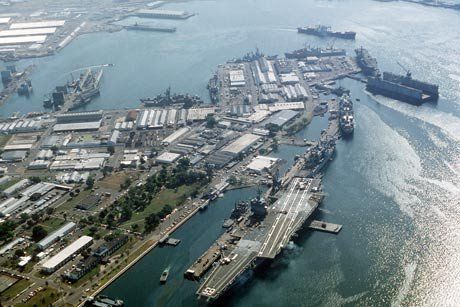Los
Angeles-class attack submarine USS Key West (SSN-722) arrived in Subic Bay in early November 2015, for a routine
port visit as part of its deployment in the Western Pacific. (Photo and
description courtesy US Navy/Jeremie Yoder, file via Philippine Star)
---
Subic Bay is still visited by US Navy ships and submarines - this is partly a warning to China not to push the Philippines around.
LATEST US WARSHIP VISITS TO SUBIC BAY AND SOMETIMES MANILA BAY:
On March 9, 2016 GMA News Online reported that US Los Angeles class submarine, USS Charlotte (SSN-766), moored at Subic Bay on March 9, 2016. US cruiser, USS Antietam, docked in Manila Bay on March 8, 2016 and 7th Fleet command ship USS Blue Ridge, docked at Subic Bay on March 4, 2016.
Early December 2015 visit to Subic Bay by USS Tucson (Los Angeles class SSN) homeported at Pearl Harbor.
November 2015 visit to Manila Bay - USS Fitzgerald (Arleigh Burke class destroyer) homeported at Yokosuka Naval Base, Japan.
The Philippine Star, November 5, 2015 reports http://www.philstar.com/headlines/2015/11/05/1518688/us-submarine-arrives-subic-after-month-sea:
LATEST US WARSHIP VISITS TO SUBIC BAY AND SOMETIMES MANILA BAY:
Update Philippines reports
Los Angeles-class USS Louisville (SSN-724) from the 7th Fleet visited
Subic Bay on February 14, 2017.
The Manila Bulletin reported
March 23, 2016 that the US Ohio class submarine USS Ohio (SSGN-726) arrived at
Subic March 22, 2016, for a scheduled port visit. It is capable of berthing more than 250 personnel. Update PH reported
March 22, 2016 that Ohio is homeported at Naval Base Kitsap in Bangor, Washington
State, USA but remains forward deployed out of Apra Harbor, Guam, for most of
its 16-month operational cycle.
On March 9, 2016 GMA News Online reported that US Los Angeles class submarine, USS Charlotte (SSN-766), moored at Subic Bay on March 9, 2016. US cruiser, USS Antietam, docked in Manila Bay on March 8, 2016 and 7th Fleet command ship USS Blue Ridge, docked at Subic Bay on March 4, 2016.
Early December 2015 visit to Subic Bay by USS Tucson (Los Angeles class SSN) homeported at Pearl Harbor.
The Philippine Star, November 5, 2015 reports http://www.philstar.com/headlines/2015/11/05/1518688/us-submarine-arrives-subic-after-month-sea:
MANILA,
Philippines — A United States Navy submarine arrived at Subic Bay on Wednesday [November 4, 2015] for a routine port visit as part of its deployment to the Western Pacific.
Los
Angeles-class fast-attack submarine USS Key West was designed for various
activities such as anti-submarine and anti-surface ship operations,
intelligence surveillance and reconnaissance.
The
US Embassy in Manila said the USS Key West's crew of 150 sailors is looking
forward to its first stop at Subic Bay after more than a month at sea.
"The
360-foot, 6,900-ton vessel remains one of the stealthiest, most formidable
submarines in the world," the embassy said in a statement. Last August,
USS Chicago [SSN-721] arrived at Subic Bay to show its latest capabilities. US
hospital ship USNS Mercy [huge at 65,000 tons] also arrived for humanitarian and relief missions.
The aircraft symbol on left shows approximate location of Subic Bay Naval and former Clark Air Bases. Aircraft symbol at right is Guam. Guam is a small island hosting a large Air Base and Naval Base Guam. (Map screenshot courtesy Viable Opposition)
BACKGROUND
USS Key West and USS Chicago are two units of the US Navy's Submarine Squadron (SUBRON) 15 homeported at Naval Base Guam.
China has started also using hospital ships like the Peace Ark Type 920 perhaps partly competing in humanitarian soft power against with USNS Mercy for regional popularity. Peace Ark provided emergency services in November 2013, at Tacloban, Philippines just after Typhoon Haiyan while the US deployed 10,000s of servicemen after Haiyan.
Subic Bay was a base for the Spanish Navy in the 19th
century and was taken over by the US following the Spanish American War in
1898. It was a US Naval
Base until 1942 when occupied by Japan (until recaptured by the US in 1945).
Subic Bay when a US Naval Base in the Cold War. Carrier shown is the USS Enterprice (CVN-65)
---
From the late 1940s to 1991
Subic Bay was a huge US base, along with nearby Clark Air Base, of great strategic value during the Cold War. Subic Bay Base was closed after 1991. Closure was due to a catastrophic eruption of nearby Mount Pinatubo dumping millions of tons of ash
on the base. The collapse of the Soviet Union in 1991 was also a cause. After the closure
enterprising Filipinos have created the successful Subic Bay Freeport Zone
which is a duty free zone like Singapore and Hong Kong.
USN Wasp Class Amphibious
Assault Ship USS Boxer (LHD-4) is guided by tugboats as it docks at the Subic Bay Freeport Zone, to join the Philippines-US Amphibious Landing Exercise starting September 18, 2013. (Photo, Jonas Reyes, Manila Bulletin)
---
After decades of agreements that gave the US great control of
territory at Subic Bay and Clark Air Base the US-Philippines
bilateral relationship now relies on Enhanced
Defense Cooperation Agreement (EDCA) - a 10 year agreement signed in 2014. The EDCA seeks
to bolster the U.S. – Philippines security relationship by allowing the United
States to station troops and operations on Philippine territory. However, the
Agreement clearly states that the U.S. is not allowed to establish a permanent
base.
On the map are the historically key strategic bases from of Cam Ranh Bay (Vietnam) and Subic Bay and Clark Air Base (Philippines)
---
---
In some respects the US Cold War bases in the
Philippines acted as a balance against Russian air and naval power centred at Cam
Ranh Bay in Vietnam. The end of the Cold War meant a decline in Russian strategic
power in Vietnam. This removed much of the reason for basing major US forces in
the Philippines.
Subic Bay may grow in strategic importance due to China's increasing challenge (particularly in the South China Sea) and a resurgent Russian military in the Asia-Pacific region.
Pete





No comments:
Post a Comment